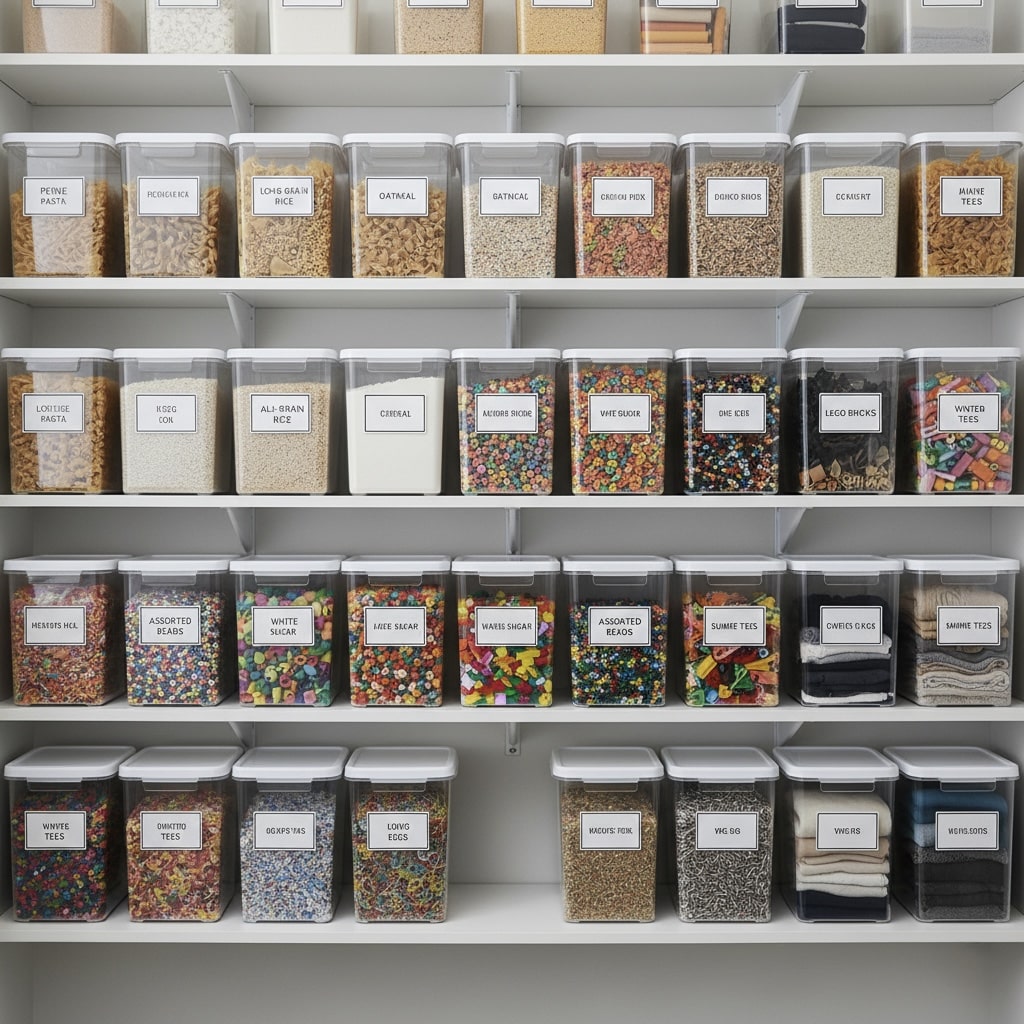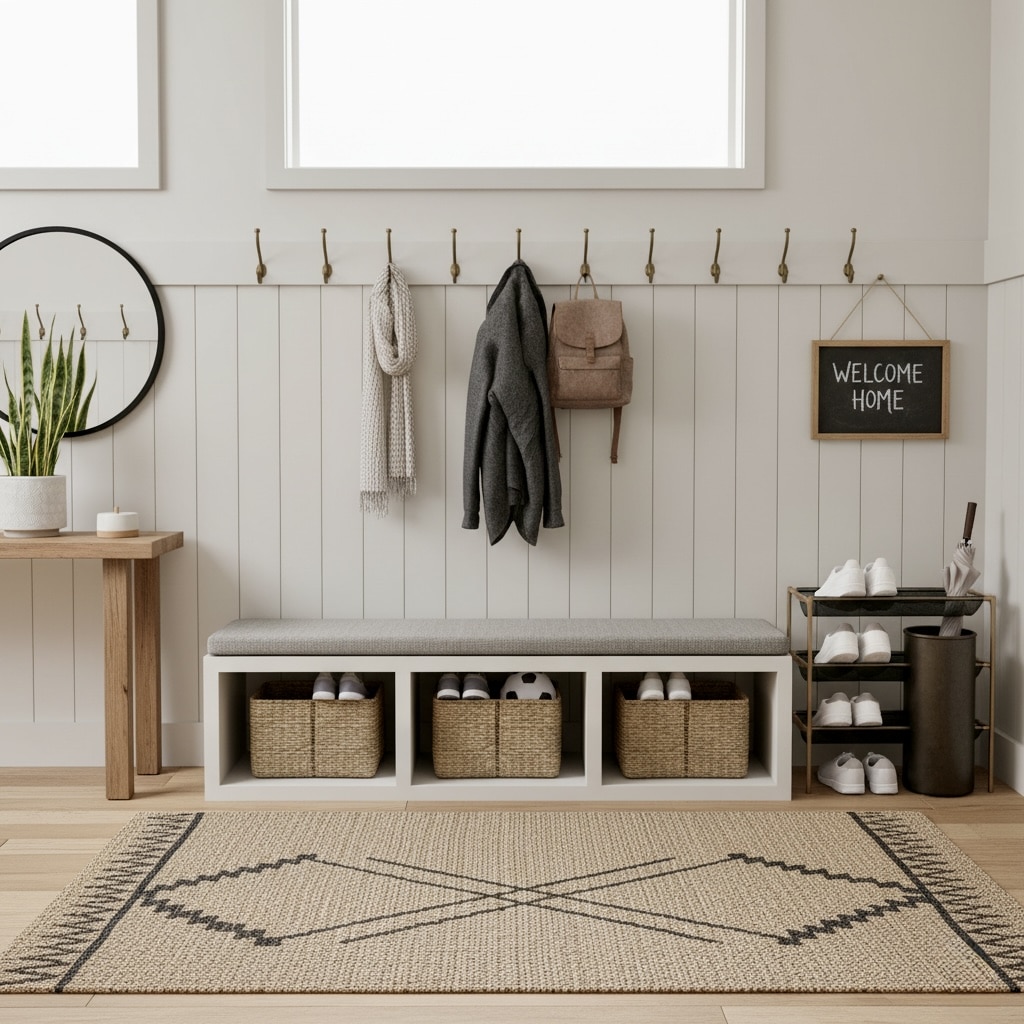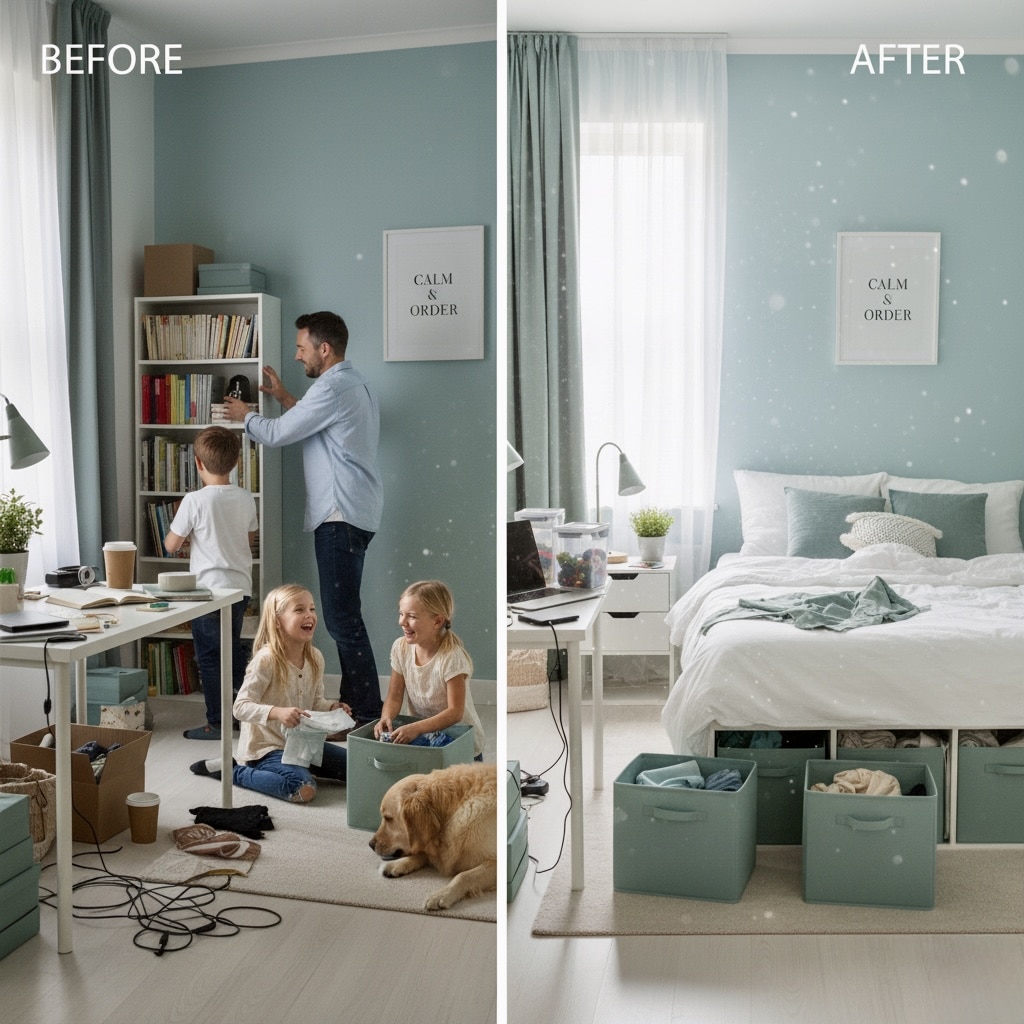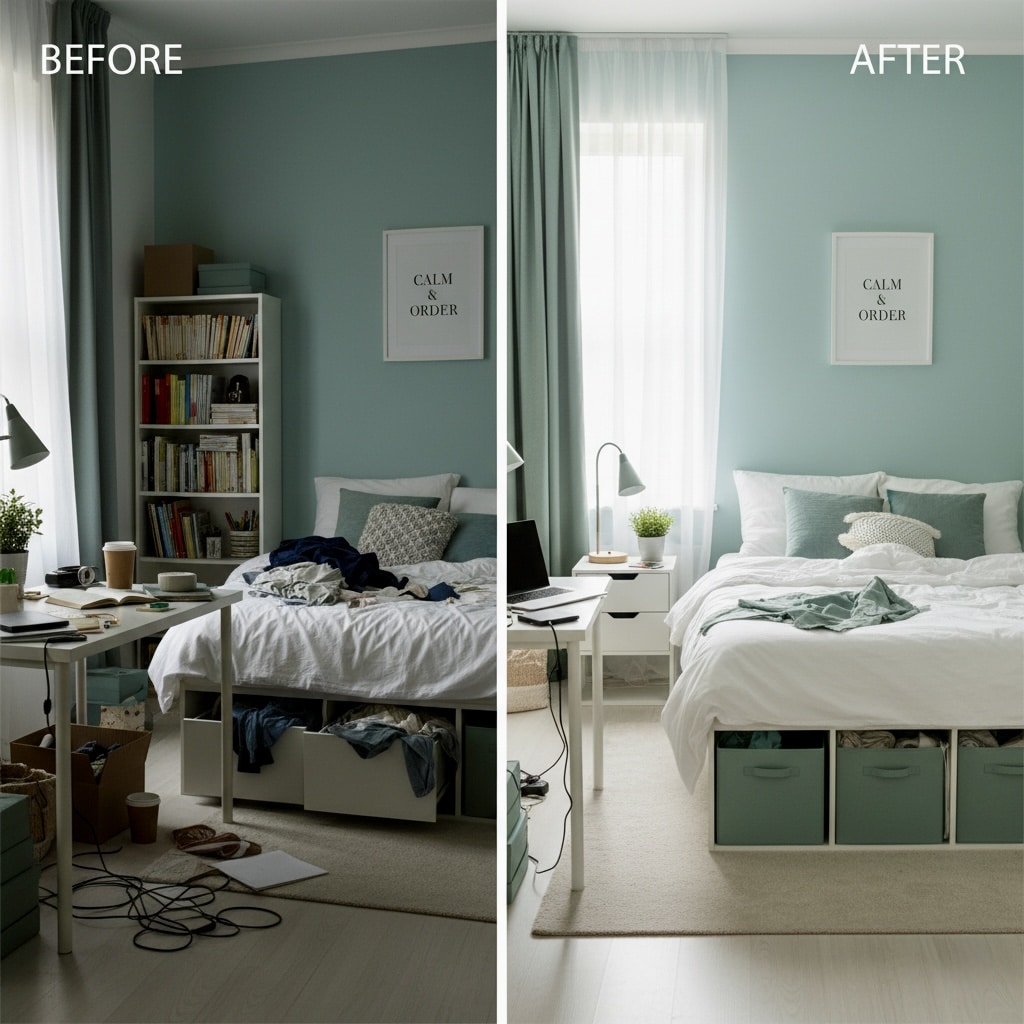Effective home organization tips serve as the foundation for creating peaceful, functional living spaces where families can thrive, relax, and enjoy their daily routines without the stress, frustration, and overwhelm that accompanies cluttered, disorganized environments that drain energy and create anxiety.
When implemented consistently and thoughtfully, effective decluttering methods transform chaotic spaces into serene sanctuaries that support productivity, reduce anxiety, improve mental clarity, and create more time for activities that truly matter to your family’s well-being, happiness, and quality of life.
Organized living directly impacts every aspect of daily life, from morning routines and meal preparation to evening relaxation and weekend activities, making the investment in home organization systems one of the most valuable improvements families can make to their overall quality of life and stress levels.
Read more: 10 Life-Changing Home Organization Tips That Transform Any SpaceThe Clutter Culture – UCLA Center for Everyday Lives study on clutter and stress
The Psychology of Organized Living
Clutter-free homes create profound psychological benefits that extend far beyond mere aesthetics, influencing mental health, family relationships, productivity levels, and overall life satisfaction in ways that many people don’t fully recognize until they experience the transformation firsthand.
Research consistently demonstrates that organized living environments reduce cortisol levels, improve sleep quality, enhance focus and concentration, boost creativity, and increase feelings of control and competence that contribute to better mental health and emotional well-being for all household members.
Learn how nutrition affects your daily mental clarity with brain-boosting foods
Visual clutter competes for attention, increases cognitive load, and creates subconscious stress that affects decision-making, emotional regulation, and energy levels throughout the day, making decluttering methods essential for mental clarity and emotional balance in modern busy households.
Furthermore, organized spaces communicate respect for belongings, family members, and guests while modeling values of stewardship, intentionality, and mindfulness that children internalize and carry forward into their own future homes and relationships.
The process of organizing also provides opportunities for family bonding, skill development, decision-making practice, and personal reflection that contribute to individual growth and family connection beyond the immediate benefits of improved living spaces.
Understanding Your Family’s Home Organization Style
Different personality types, learning styles, and family dynamics require customized approaches to home storage solutions rather than one-size-fits-all systems that may work well for some families but create frustration and failure for others with different needs and preferences.
Visual learners may prefer open storage systems where belongings are easily visible, while others function better with concealed storage that creates clean, minimalist environments that support focus and relaxation without visual distractions.
Families with young children need different organizational strategies than empty nesters, and busy working parents require systems that accommodate quick cleanup and maintenance rather than elaborate organization schemes that demand significant time investment daily.
Consider individual family members’ habits, preferences, and natural tendencies when designing organizational systems, working with rather than against natural inclinations to create sustainable systems that support rather than fight daily routines and behavior patterns.
Some family members are natural organizers who enjoy detailed systems and maintenance routines, while others prefer simple, low-maintenance approaches that require minimal daily attention but still provide functional, attractive living spaces.
Creating Your Organization Foundation
Before implementing specific home organization tips, establish foundational principles that guide decision-making and ensure that organizational efforts align with family values, lifestyle needs, and long-term goals rather than temporary aesthetic preferences or external expectations.
Define what “organized” means for your family based on your lifestyle, values, and priorities rather than comparing your home to social media images or other families whose circumstances, preferences, and needs may differ significantly from your own situation.
Identify your family’s primary organization challenges and pain points, focusing initial efforts on areas that create the most stress, waste the most time, or cause the most conflict rather than starting with spaces that are already functional.
Establish realistic expectations about the time investment required for initial organization projects and ongoing maintenance, understanding that sustainable systems develop gradually rather than overnight and require consistent effort from all family members.
Consider your budget for organization supplies and storage solutions, recognizing that effective organization often requires some investment in containers, shelving, and systems but doesn’t necessarily require expensive solutions or complete room makeovers.

1. Start with the One-Room Rule
Home storage solutions work best when implemented gradually and systematically rather than attempting to organize entire homes simultaneously, which often leads to overwhelm, incomplete projects, and abandoned organization efforts that create more chaos than improvement.
Choose one room to focus on completely before moving to the next space, ensuring sustainable progress and avoiding the feeling of being overwhelmed by the enormity of organizing an entire household while building confidence through completed projects.
This methodical approach allows you to develop organizing skills, test different storage systems, experiment with clutter-free home solutions, and build momentum while creating immediate visible improvements that motivate continued effort throughout your home transformation journey.
Start with the room that causes the most daily stress or affects the most family members, such as the kitchen, entryway, or main living area, creating immediate impact that benefits everyone while providing motivation for continued organization projects.
Complete each room thoroughly before moving on, including decluttering, deep cleaning, organizing remaining items, implementing storage systems, and establishing maintenance routines that ensure the space stays organized long-term rather than reverting to chaos.
Document your progress through before and after photos that provide motivation during challenging moments and help you remember effective strategies and solutions that worked well for your family’s specific needs and preferences.
2. Apply the Three-Box Sorting System
Decluttering methods become more manageable and effective when you sort items into three clear categories: keep, donate, and discard, forcing decision-making while preventing the common trap of simply moving clutter from one location to another without actually reducing overall volume.
Label boxes clearly and commit to following through with donations and disposal within one week of sorting, preventing sorted items from becoming new clutter that undermines your organizational efforts and creates additional stress and visual chaos.
Use specific criteria for each category to speed decision-making and reduce emotional attachment that can slow the decluttering process, such as keeping items used within the past year, donating items in good condition that might benefit others, and discarding broken or worn items.
Make decisions quickly rather than agonizing over individual items, trusting your initial instincts and remembering that the goal is creating functional, peaceful living spaces rather than preserving every potentially useful item that might be needed someday.
Include family members in age-appropriate sorting decisions, teaching children valuable skills in decision-making, critical thinking, and value assessment while ensuring that personal belongings are handled respectfully and individual preferences are considered.
Consider adding a fourth category for items that need repair, cleaning, or relocation to other areas of the home, preventing these items from being mixed with clear keep, donate, or discard decisions that could slow the sorting process.
3. Implement the One-In, One-Out Policy
Organized living requires ongoing maintenance and conscious consumption decisions that prevent new clutter from accumulating faster than existing items are removed or organized within your newly structured spaces and storage systems.
Before bringing new items into your home, identify similar items to remove, donate, or discard, ensuring that your possessions remain at manageable levels that support rather than overwhelm your organizational systems and available storage capacity.
This policy helps develop mindful consumption habits, reduces impulse purchases that often become clutter, and maintains the balance you’ve worked hard to achieve through your initial organization efforts and investment of time and energy.
Apply this organizing principle to all categories including clothing, books, toys, kitchen gadgets, decorative items, and household supplies, preventing any single category from growing beyond your storage capacity or organizational systems’ ability to maintain order.
Teach children age-appropriate organizational skills while making tidying and organization positive family activities that build life skills, responsibility, and pride in maintaining shared living spaces that benefit everyone.
Creating meaningful family traditions can strengthen these organizational habits.
Make exceptions thoughtfully and temporarily for special circumstances such as holidays, birthdays, or seasonal needs while returning to the one-in, one-out policy to maintain long-term organization and prevent temporary exceptions from becoming permanent habits.
4. Create Designated Homes for Everything
These organizing strategies emphasize that every item should have a specific, logical location where it belongs and returns after use, eliminating the guesswork that leads to items being placed randomly and eventually becoming lost, misplaced, or contributing to clutter accumulation.
Choose storage locations based on frequency of use, convenience factors, and logical associations, with daily items in easily accessible spots and seasonal items in higher or less convenient locations that still remain organized and clearly labeled for easy retrieval.
Consider the natural flow of daily activities when assigning homes to belongings, placing items near where they’re used most frequently while ensuring that storage locations make sense to all family members who need to access and return items.
Use labels, pictures, or color-coding systems that help all family members, including children and guests, understand where items belong and can easily return things to their designated homes after use.
Evaluate and adjust storage locations based on actual usage patterns rather than theoretical ideals, moving items that consistently end up in wrong locations to spots that better accommodate natural family behavior and daily routines.
Create temporary homes for items in transition, such as library books that need to be returned, items that need repair, or belongings that are being evaluated for donation, preventing these temporary items from disrupting established organizational systems.
National Association of Productivity and Organizing Professionals
5. Maximize Vertical Storage Space
Clutter-free homes utilize all available storage dimensions, including walls, backs of doors, and high shelves that often remain underutilized in traditionally organized spaces, dramatically increasing storage capacity without requiring additional floor space or major renovations.
Install shelving, hooks, and hanging organizers that take advantage of vertical space while maintaining easy access to frequently used items and keeping visual clutter to a minimum through strategic placement and attractive storage solutions.
Use wall-mounted systems for items like cleaning supplies, craft materials, office supplies, or seasonal decorations that don’t require daily access but need organized storage that keeps them accessible when needed.
Consider the visual impact of vertical storage solutions, choosing options that complement your home’s aesthetic while providing functional storage that enhances rather than detracts from your living space’s appearance and atmosphere.
Ensure that high storage remains accessible through step stools, proper shelving systems, or pulldown mechanisms that allow safe retrieval of stored items without creating safety hazards or inconvenience that discourages proper storage habits.
Rotate items between high and low storage based on seasonal usage patterns, keeping currently relevant items in easily accessible locations while moving off-season items to higher storage areas that free up prime storage space.
6. Establish Daily 15-Minute Tidying Sessions
Home storage solutions remain effective only when supported by consistent maintenance habits that prevent new clutter from accumulating and undoing your organizational efforts, time investment, and the progress you’ve made toward creating peaceful living spaces.
Set a timer for 15 minutes each evening and have family members work together to return items to their designated homes, wipe surfaces clean, and complete quick tasks that maintain organization without feeling overwhelming or time-consuming.
These daily sessions create sustainable habits that maintain your organized spaces effortlessly while teaching children responsibility, teamwork, and the value of maintaining shared living spaces through consistent daily effort rather than overwhelming periodic cleanup sessions.
Focus on returning displaced items to their homes rather than deep cleaning or major reorganization during these brief sessions, keeping the task manageable and achievable even during busy periods when energy and time are limited.
Celebrate the completion of daily tidying sessions and acknowledge family members’ contributions to maintaining organized spaces, creating positive associations with organization maintenance that encourage continued participation and cooperation.
Adjust timing and expectations based on family schedules and energy levels, understanding that consistency matters more than perfection and that brief daily attention prevents the need for overwhelming weekend organization marathons.
Discover how morning routines can complement your organization efforts.

7. Use Clear Storage Containers Strategically
Decluttering methods improve significantly when you can easily see stored items without opening multiple containers or boxes, reducing the time spent searching for belongings while protecting items from dust, moisture, damage, and pest intrusion.
Clear storage allows for quick identification of contents, inventory assessment, and efficient retrieval while maintaining organized appearance that contributes to visual calm and orderly environments throughout your home.
Label containers clearly with both words and pictures for family members who may not read well, ensuring that organizational systems remain accessible and usable for all household members regardless of age, reading ability, or familiarity with the system.
Choose container sizes that fit your storage spaces and items appropriately, avoiding oversized containers that waste space or undersized options that lead to overflowing and disorganized appearance that defeats the purpose of containerized storage.
Invest in quality containers that stack securely, seal properly, and withstand regular use without breaking or deteriorating, understanding that good storage containers are long-term investments in home organization that pay dividends through years of functional use.
Standardize container sizes when possible to maximize storage efficiency, create visual consistency, and allow for flexible storage arrangements that can adapt to changing needs and contents over time.
8. Organize by Category, Not Location
Organized living becomes more logical and efficient when similar items are stored together regardless of where they might traditionally belong, making it easier to see quantities, avoid duplicates, assess needs, and access everything you need for specific activities or projects.
Group all cleaning supplies, all office materials, all craft items, or all seasonal decorations in dedicated zones rather than scattering them throughout multiple rooms where they become forgotten, duplicated, or difficult to locate when needed.
This approach helps prevent overbuying, reduces waste, improves inventory management, and ensures that you can find what you need quickly without searching multiple locations or purchasing items you already own but can’t locate.
Create category-based storage zones that accommodate all items in each category while allowing for growth and seasonal variations that might affect storage needs throughout the year.
Use portable containers or caddies that allow you to transport entire categories of supplies to where they’re needed, such as cleaning caddies, craft bins, or homework stations that keep related items together while providing flexibility.
Evaluate categories regularly to ensure they still make sense for your family’s current needs and usage patterns, adjusting groupings as interests change, children grow, or household needs evolve over time.

9. Create Functional Entry and Exit Zones
Household organization strategies include establishing dedicated areas near entrances where keys, mail, shoes, bags, and daily essentials have designated storage, preventing these items from spreading throughout your living spaces and creating clutter in main areas.
Install hooks, baskets, small furniture pieces, and organizational systems that accommodate your family’s specific needs while maintaining an attractive appearance that welcomes both family members and guests into your organized home.
Design entry zones that handle your family’s reality rather than an idealized version, including adequate storage for coats, bags, sports equipment, or work materials that actually get used daily rather than theoretical organization that doesn’t match actual family patterns.
Include systems for managing mail, important papers, and time-sensitive documents that require action, preventing these items from creating clutter while ensuring they don’t get lost or forgotten in organizational systems.
Create designated spaces for items that regularly travel in and out of the home, such as library books, gym bags, work materials, or school supplies, preventing these transient items from disrupting main organizational systems.
Consider seasonal needs when designing entry systems, accommodating winter coats, summer beach gear, or sports equipment that changes throughout the year while maintaining year-round functionality and organization.
10. Schedule Regular Decluttering Reviews
Clutter-free homes require periodic assessment and adjustment as family needs change, seasons transition, life circumstances evolve, and interests shift, making flexible organizational systems essential for long-term success and continued functionality.
Schedule quarterly reviews where you reassess storage needs, donate items no longer used, evaluate system effectiveness, and adjust organizational approaches to better serve your family’s current lifestyle, priorities, and space requirements.
Use these review periods to involve family members in evaluating what’s working well and what needs improvement, ensuring that organizational systems continue serving everyone’s needs rather than becoming rigid requirements that don’t adapt to changing circumstances.
During reviews, celebrate organizational successes, acknowledge areas for improvement, and make specific plans for addressing challenges or ineffective systems that have developed since your last evaluation period.
Document what works well for your family so you can replicate successful strategies in other areas while learning from less effective approaches that can guide future organizational decisions and investments.
Consider seasonal decluttering that aligns with natural transition periods like spring cleaning, back-to-school preparation, or holiday decorating when families naturally evaluate and adjust their living spaces and storage needs.
Building Sustainable Home Organization Habits
Household organization solutions succeed when they align with your family’s natural habits and preferences rather than fighting against them, requiring honest assessment of actual behavior patterns versus idealized intentions about how family members should behave.
Remember that perfect organization matters less than functional organization that serves your family’s needs, reduces stress in daily routines, and supports the activities and relationships that matter most to your family’s happiness and well-being.
Focus on progress rather than perfection, understanding that organization is an ongoing process rather than a destination, and that effective systems evolve over time as family needs, circumstances, and preferences change.

Involving the Whole Family
Organized living works best when all family members understand, participate in, and take ownership of maintaining organizational systems rather than viewing organization as one person’s responsibility or burden that others can ignore.
Teach children age-appropriate organizational skills while making tidying and organization positive family activities that build life skills, responsibility, and pride in maintaining shared living spaces that benefit everyone.
Assign specific organizational responsibilities to each family member based on their abilities and interests, creating shared ownership of maintaining your newly organized spaces while distributing the workload fairly among all household members.
Create family organization goals, celebrate successes together, and work as a team to overcome challenges that arise, understanding that effective organization requires ongoing cooperation and commitment from everyone who lives in and benefits from organized spaces.
Maintaining Your Progress Long-Term
Decluttering methods and organizational systems require ongoing attention and adjustment, but the effort invested pays tremendous dividends in time saved, stress reduced, and enjoyment increased in your home environment that supports your family’s goals and values.
Celebrate your organizational victories, learn from setbacks, and remember that organization is an ongoing process rather than a one-time project that requires continuous refinement, adaptation, and maintenance throughout changing life circumstances.
Focus on creating systems that serve your family’s specific needs rather than achieving perfect organization that may look beautiful but doesn’t function well for your actual lifestyle, priorities, and daily routines.
The investment you make in implementing these home organization tips creates benefits that extend far beyond tidy spaces, influencing family relationships, stress levels, productivity, and overall quality of life that supports your family’s happiness and well-being for years to come.
These home organization tips create lasting transformation.
A healthy lifestyle late in life still offers benefits


Organized family living spaces are excellent for promoting healthy dialogue, mental health, and strengthening emotional bonds between children and their parents. I really enjoyed the tips in this article. Congratulations!
Thank you!